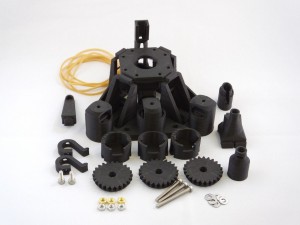 OK, you use your smartphone all the time: you use the latest and greatest apps, you can text or tweet with the best of them, you have the knack for selfies, and so on. You probably also have a computer, tablet, and a gaming system, each of which you are also very proficient with. No question: you are a whiz with electronic devices. But, if you're like most of us, you don't really know how or why they work. Maybe that's OK. Most of us don't know how our cars work either, couldn't explain how heavier-than-air flight is possible, have no idea what the periodic table means to our daily lives, and would be in trouble if our lives depending on us making, say, bricks or glass...
OK, you use your smartphone all the time: you use the latest and greatest apps, you can text or tweet with the best of them, you have the knack for selfies, and so on. You probably also have a computer, tablet, and a gaming system, each of which you are also very proficient with. No question: you are a whiz with electronic devices. But, if you're like most of us, you don't really know how or why they work. Maybe that's OK. Most of us don't know how our cars work either, couldn't explain how heavier-than-air flight is possible, have no idea what the periodic table means to our daily lives, and would be in trouble if our lives depending on us making, say, bricks or glass...
Raspberry Pi
See the following -
10 Things The Open Source Community Got Right In 2013
The year 2013 was one of the best years for open source in recent memory. It seemed like every month of the year brought yet another announcement either by or for the community that celebrates all things Linux and open source. [...] Does this mean Linux has finally made its way to mass acceptance? The answer is that it's very, very close. Let's take a look at the 2013 successes before we draw our final conclusion. Read More »
- Login to post comments
3D Printed Microscopes to Boost Science in Developing Countries
 Dr Richard Bowman from the Department of Physics, working with collaborators at the University of Cambridge and Tanzanian “digital blacksmiths” STICLab, wants to create much cheaper, open-source devices such as microscopes which can be used for disease diagnosis and scientific research. The three-year project, funded through the Global Challenges Research Fund, is testing and refining a prototype general purpose optical microscope made from mass produced lenses, a Raspberry Pi mini-computer and a 3D-printed plastic frame...
Dr Richard Bowman from the Department of Physics, working with collaborators at the University of Cambridge and Tanzanian “digital blacksmiths” STICLab, wants to create much cheaper, open-source devices such as microscopes which can be used for disease diagnosis and scientific research. The three-year project, funded through the Global Challenges Research Fund, is testing and refining a prototype general purpose optical microscope made from mass produced lenses, a Raspberry Pi mini-computer and a 3D-printed plastic frame...
- Login to post comments
5 DIY Hardware Platforms for Physiological Computing
 Physiological computing focuses on the use of biosignals for the development of interactive software and hardware systems capable of sensing, processing, reacting, and interfacing the digital and analog worlds. However, biosignals have specific requirements for which typical physical computing platforms are not particularly tuned. Until recently, many projects ended up hindered by high costs and limited access to suitable hardware materials. That scenario is different today, partially thanks to the following 5 DIY hardware platforms...
Physiological computing focuses on the use of biosignals for the development of interactive software and hardware systems capable of sensing, processing, reacting, and interfacing the digital and analog worlds. However, biosignals have specific requirements for which typical physical computing platforms are not particularly tuned. Until recently, many projects ended up hindered by high costs and limited access to suitable hardware materials. That scenario is different today, partially thanks to the following 5 DIY hardware platforms...
- Login to post comments
5 Ways to Invigorate Education with Raspberry Pi
 Recently I was invited to talk to a group of eighth grade students about the Raspberry Pi. Of the 15 students and three teachers there, only a few had heard of the Raspberry Pi. None had ever held one in their hand, nor did they know how to set one up or even where to look for information to do so. I spent 40 minutes talking to them and inviting them to explore the Raspberry Pi and the wealth of high-quality, open source software that comes with it. They were energized and eager to learn more...I think something needs to be done, so I am inviting fellow open source advocates to join me in making minor investments in their communities to move the ball forward.
Recently I was invited to talk to a group of eighth grade students about the Raspberry Pi. Of the 15 students and three teachers there, only a few had heard of the Raspberry Pi. None had ever held one in their hand, nor did they know how to set one up or even where to look for information to do so. I spent 40 minutes talking to them and inviting them to explore the Raspberry Pi and the wealth of high-quality, open source software that comes with it. They were energized and eager to learn more...I think something needs to be done, so I am inviting fellow open source advocates to join me in making minor investments in their communities to move the ball forward.
- Login to post comments
7 Cool Little Open Source Projects That Stood Out in 2016
 In the early days of the open source movement, a lot of the attention was on operating systems, and later on large content management systems. These days, containers are mentioned regularly even in mainstream news outlets. The big tech stories are great, but they miss the other great activity in the niches of the open source space. I've rounded up seven interesting lesser-known projects from the past year. You can see more articles about projects like this in my Nooks and Crannies column...
In the early days of the open source movement, a lot of the attention was on operating systems, and later on large content management systems. These days, containers are mentioned regularly even in mainstream news outlets. The big tech stories are great, but they miss the other great activity in the niches of the open source space. I've rounded up seven interesting lesser-known projects from the past year. You can see more articles about projects like this in my Nooks and Crannies column...
- Login to post comments
A Hardware Renaissance In Silicon Valley
In recent years, Silicon Valley seems to have forgotten about silicon. It’s been about dot-coms, Web advertising, social networking and apps for smartphones. But there are signs here that hardware is becoming the new software. Read More »
- Login to post comments
A Look at Open Source Image Recognition Technology
 Image recognition technology promises great potential in areas from public safety to healthcare...At the Supercomputing Conference in Denver last year, I discovered an interesting project as I walked the expo floor. A PhD student from Louisiana State University, Shayan Shams, had set up a large monitor displaying a webcam image. Overlaid on the image were colored boxes with labels. As I looked closer, I realized the labels identified objects on a table. Of course, I had to play with it. As I moved each object on the table, its label followed. I moved some objects that were off-camera into the field of view, and the system identified them too.
Image recognition technology promises great potential in areas from public safety to healthcare...At the Supercomputing Conference in Denver last year, I discovered an interesting project as I walked the expo floor. A PhD student from Louisiana State University, Shayan Shams, had set up a large monitor displaying a webcam image. Overlaid on the image were colored boxes with labels. As I looked closer, I realized the labels identified objects on a table. Of course, I had to play with it. As I moved each object on the table, its label followed. I moved some objects that were off-camera into the field of view, and the system identified them too.
- Login to post comments
A Miniature 'Open Source' Mobile Clinic For The Developing World
Basic medical tests once required a trip to a clinic. These days, anyone can measure their pulse, heart rate, and blood pressure using cheap digital equipment. Read More »
- Login to post comments
Arduino Creator Explains Why Open Source Matters In Hardware, Too
Most of the technology world is familiar with open source software and the reasons why, in some eyes, it's more appealing than proprietary software. When software's source code is available for anyone to inspect, it can be examined for security flaws, altered to suit user wishes, or used as the basis for a new product. Read More »
- Login to post comments
Barcelona Digital Technology Centre Delivers E-Health and Smart Home Platform Using the WSO2 Carbon Platform
Recently, BDigital developed eKauri, a non-invasive e-health and smart home platform that empowers seniors to gain autonomy, participate in modern society, and improve quality of life. Using WSO2’s pre-integrated products, the company delivered the first minimally viable version of the product three months ahead of schedule. The case study discusses BDigital’s RESTful architecture and its decision to run applications in the cloud to address the low memory capacity of Internet of Things components. It also examines... Read More »
- Login to post comments
Best Of Open Hardware In 2014
Open hardware is the physical foundation of the open movement. It is through understanding, designing, manufacturing, commercializing, and adopting open hardware, that we built the basis for a healthy and self-reliant community of open. And the year of 2014 had plenty of activities in the open hardware front...
- Login to post comments
Build Your Own Open Source Artificial Pancreas System to Regulate Insulin Delivery
 In her Day 2 OSCON keynote, Dana set out reminding us that Type I diabetes, suffered by millions of people around the world, is incredibly complicated to manage...The solution is an artificial pancreas, which acts to close that loop by monitoring and adjusting insulin levels, just as the normal pancreas does. But those devices are not yet available on the commercial market, and won't be for some years yet. Enter the OpenAPS project (Open Artificial Pancreas System); find it here on GitHub. "OpenAPS is a simplified Artificial Pancreas System (APS) designed to automatically adjust an insulin pump's basal insulin delivery to keep blood glucose (BG) in a safe range overnight and between meals"..
In her Day 2 OSCON keynote, Dana set out reminding us that Type I diabetes, suffered by millions of people around the world, is incredibly complicated to manage...The solution is an artificial pancreas, which acts to close that loop by monitoring and adjusting insulin levels, just as the normal pancreas does. But those devices are not yet available on the commercial market, and won't be for some years yet. Enter the OpenAPS project (Open Artificial Pancreas System); find it here on GitHub. "OpenAPS is a simplified Artificial Pancreas System (APS) designed to automatically adjust an insulin pump's basal insulin delivery to keep blood glucose (BG) in a safe range overnight and between meals"..
- Login to post comments
Build Your Own Supercomputer Out Of Raspberry Pi Boards
Who says you need a few million bucks to build a supercomputer? Joshua Kiepert put together a Linux-powered Beowulf cluster with Raspberry Pi computers for less than $2,000. Read More »
- Login to post comments
Building a Business on a Solid Open Source Model
 Since we announced Nextcloud, an ownCloud fork, many people have asked me how we plan to build a sustainable, healthy open source business. My short answer is that it requires a strong focus on maintaining a careful balance between the needs of all stakeholders: users, contributors, employees, customers, and—of course—investors. Building a solid open source business requires that management has confidence in the abilities of your company, stakeholders must be on board with the business model, and everyone must understand that balance is important for the ecosystem. Like a rising tide lifts all boats, a strong ecosystem benefits all stakeholders...
Since we announced Nextcloud, an ownCloud fork, many people have asked me how we plan to build a sustainable, healthy open source business. My short answer is that it requires a strong focus on maintaining a careful balance between the needs of all stakeholders: users, contributors, employees, customers, and—of course—investors. Building a solid open source business requires that management has confidence in the abilities of your company, stakeholders must be on board with the business model, and everyone must understand that balance is important for the ecosystem. Like a rising tide lifts all boats, a strong ecosystem benefits all stakeholders...
- Login to post comments
Computational Thinking in Healthcare
- Login to post comments